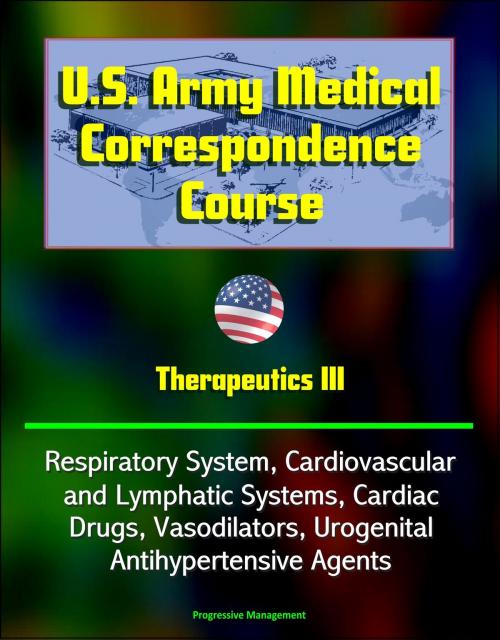U.S. Army Medical Correspondence Course: Therapeutics III - Respiratory System, Cardiovascular and Lymphatic Systems, Cardiac Drugs, Vasodilators, Urogenital, Antihypertensive Agents
Nonfiction, Health & Well Being, Medical, Specialties, Pharmacy| Author: | Progressive Management | ISBN: | 9781311975003 |
| Publisher: | Progressive Management | Publication: | October 22, 2014 |
| Imprint: | Smashwords Edition | Language: | English |
| Author: | Progressive Management |
| ISBN: | 9781311975003 |
| Publisher: | Progressive Management |
| Publication: | October 22, 2014 |
| Imprint: | Smashwords Edition |
| Language: | English |
Drugs that act upon the respiratory system, cardiovascular system, or urinary system are frequently dispensed in both military and civilian pharmacies. This is because conditions that affect these systems (that is, hypertension affecting the cardiovascular system) affect many people. Consequently, it is imperative that you have an understanding of these systems and the drugs that act on them.
As with MD0804 (Therapeutics I) and MD0805 (Therapeutics II), anatomy, physiology, and pharmacology are presented in a combined perspective. This is done to help you to understand and remember the actions, uses, side effects, and patient warnings associated with the drugs included in these lessons.
This subcourse is approved for resident and correspondence course instruction. It reflects the current thought of the Academy of Health Sciences and conforms to printed Department of the Army doctrine as closely as currently possible.
INTRODUCTION * CHAPTER 1 - THE RESPIRATORY SYSTEM AND RESPIRATORY SYSTEM DRUGS * Section I. The Respiratory System * Section II. Breathing and Breathing Mechanisms in Humans * Section III. Conditions Affecting the Respiratory System * Section IV. Respiratory System Drugs * Exercises * CHAPTER 2 - THE HUMAN CARDIOVASCULAR AND LYMPHATIC SYSTEMS * Section I. Introduction * Section II. The Human Cardiovascular System * Section III. The Heart and the Systemic Circulation of Blood * Section IV. The Human Lymphatic System * Exercises * CHAPTER 3 - CARDIAC DRUGS * Section I. Congestive Heart Failure and Its Treatment * Section II. The Antiarrhythmic Agents * Section III. Antihyperlipidemics Agents * Exercises * CHAPTER 4 - VASODILATOR DRUGS * Section I. Introduction * Section II. Vasodilator Drugs * Exercises * CHAPTER 5 - DRUGS ACTING ON THE HEMATOPOIETIC SYSTEM * Section I. Introduction * Section II. Coagulants * Section III. Anticoagulants * Section IV. Hematinics * Section V. Stimulating Factors * Exercises * CHAPTER 6 - THE HUMAN UROGENITAL SYSTEMS * Section I. Overview of the Urogenital Systems * Section II. The Human Urinary System * Section III. Introduction to Human Genital (Reproductive) Systems * Section IV. The Human Female Genital (Reproductive) System * Section V. The Human Male Genital (Reproductive) System * Exercises * CHAPTER 7 - ANTIHYPERTENSIVE AGENTS * Section I. Introduction to Hypertension * Section II. Drugs Used in the Treatment of Hypertension * Exercises * CHAPTER 8 - DIURETIC AND ANTIDIURETIC AGENTS * Section I. Diuretics Agents * Section II. Antidiuretic Agents. Exercises * CHAPTER 9 - TOXICOLOGY AND POISON CONTROL * Section I. Introduction * Section II. The Pharmacy and Poison Prevention * Section III. The Treatment of Poisoning * Section IV. Poison Control and Information * Exercises * ANNEX: Drug Pronunciation Guide
Drugs that act upon the respiratory system, cardiovascular system, or urinary system are frequently dispensed in both military and civilian pharmacies. This is because conditions that affect these systems (that is, hypertension affecting the cardiovascular system) affect many people. Consequently, it is imperative that you have an understanding of these systems and the drugs that act on them.
As with MD0804 (Therapeutics I) and MD0805 (Therapeutics II), anatomy, physiology, and pharmacology are presented in a combined perspective. This is done to help you to understand and remember the actions, uses, side effects, and patient warnings associated with the drugs included in these lessons.
This subcourse is approved for resident and correspondence course instruction. It reflects the current thought of the Academy of Health Sciences and conforms to printed Department of the Army doctrine as closely as currently possible.
INTRODUCTION * CHAPTER 1 - THE RESPIRATORY SYSTEM AND RESPIRATORY SYSTEM DRUGS * Section I. The Respiratory System * Section II. Breathing and Breathing Mechanisms in Humans * Section III. Conditions Affecting the Respiratory System * Section IV. Respiratory System Drugs * Exercises * CHAPTER 2 - THE HUMAN CARDIOVASCULAR AND LYMPHATIC SYSTEMS * Section I. Introduction * Section II. The Human Cardiovascular System * Section III. The Heart and the Systemic Circulation of Blood * Section IV. The Human Lymphatic System * Exercises * CHAPTER 3 - CARDIAC DRUGS * Section I. Congestive Heart Failure and Its Treatment * Section II. The Antiarrhythmic Agents * Section III. Antihyperlipidemics Agents * Exercises * CHAPTER 4 - VASODILATOR DRUGS * Section I. Introduction * Section II. Vasodilator Drugs * Exercises * CHAPTER 5 - DRUGS ACTING ON THE HEMATOPOIETIC SYSTEM * Section I. Introduction * Section II. Coagulants * Section III. Anticoagulants * Section IV. Hematinics * Section V. Stimulating Factors * Exercises * CHAPTER 6 - THE HUMAN UROGENITAL SYSTEMS * Section I. Overview of the Urogenital Systems * Section II. The Human Urinary System * Section III. Introduction to Human Genital (Reproductive) Systems * Section IV. The Human Female Genital (Reproductive) System * Section V. The Human Male Genital (Reproductive) System * Exercises * CHAPTER 7 - ANTIHYPERTENSIVE AGENTS * Section I. Introduction to Hypertension * Section II. Drugs Used in the Treatment of Hypertension * Exercises * CHAPTER 8 - DIURETIC AND ANTIDIURETIC AGENTS * Section I. Diuretics Agents * Section II. Antidiuretic Agents. Exercises * CHAPTER 9 - TOXICOLOGY AND POISON CONTROL * Section I. Introduction * Section II. The Pharmacy and Poison Prevention * Section III. The Treatment of Poisoning * Section IV. Poison Control and Information * Exercises * ANNEX: Drug Pronunciation Guide















